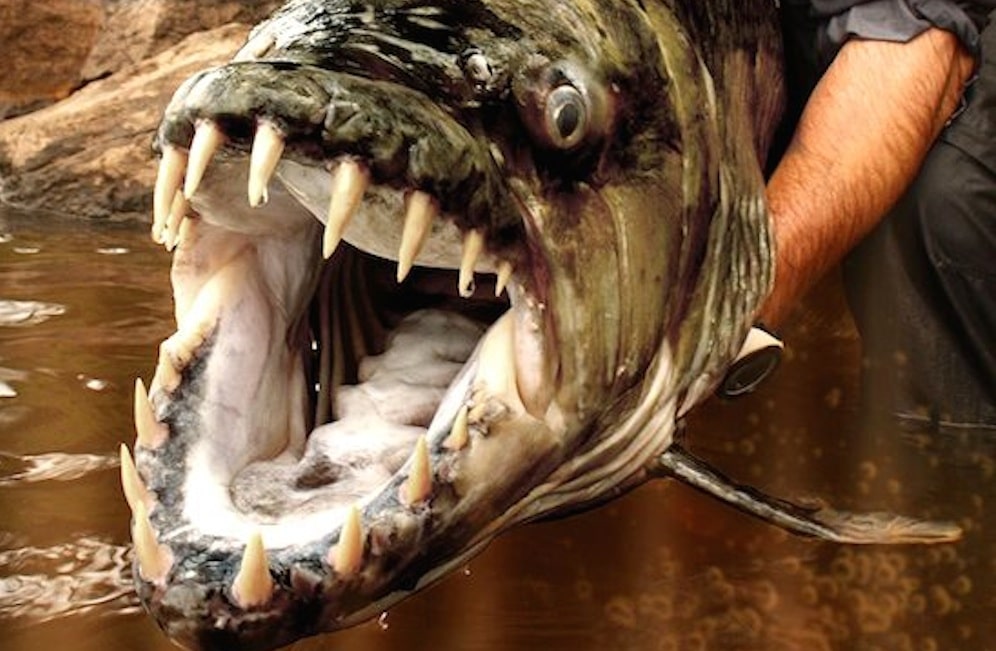The Goliath Tigerfish is the largest species of tigerfish. The Goliath Tiger Fish is possibly the most terrifyingly dangerous freshwater fish in the world. It is even more dangerous than the Piranha because of its enormous size. And It is also the most dangerous fish in Africa. It is native to the Congo River basin, the Lualaba River, Lake Upemba, and Lake Tanganyika in Africa.
The goliath tigerfish is also known as the giant tigerfish and the giant African tigerfish. It’s sometimes also called a Mbenga after the evil spirits of local tribes.
Its scientific name is Hydrocynus Goliath and belongs to the genus Hydrocynus which contains five species known as African Tigerfish, popular for their fierce predatory behavior. It has gained a mythical reputation among anglers because of its aggressive predatory nature and strength.

Goliath Tigerfish Behavior
Not much is known about their behavior further there hasn’t been a lot of research into the goliath tigerfish. One thing that we know for sure they are fierce predators. They’re known as fierce, aggressive species that can eat anything in the water. The only known predator of mature goliath tigerfish is the Nile crocodile.
They have excellent eyesight, so goliath tigerfish track their prey with their eyes. When hunting, this fish uses the calmer eddies of the rapids to ambush its prey.
They also have the ability to detect low-level frequencies in the water, so when a fish is swimming nearby, the goliath tigerfish can sense them.
When a target is noticed, the fish accelerates to chase it down. Then they slice their prey in pieces with their sharp teeth. They don’t use their teeth for chewing, once their victim is in pieces, goliath tigerfish swallow the whole of the parts.
Tiger Goliath fish Appearance
Just imagine crossing a shark with a piranha this is how you will describe the Goliath tigerfish at first glance. It can measure more than 1.8 meters in length and exceed 70 kilos in weight. Its enormous mouth with 32 large teeth sharp as knives is capable of cutting its prey in half.
Their scales are white, yellow, brown and gray with a golden flush around the face. The dorsal fin is upright, which looks like a shark. Three smaller fins are found below the belly.

Each tooth can be up to one inch long. The Goliath’s teeth are set at the edge of the jaw — the monster has barely any lips. There have been numerous reports of the goliath tiger that has attacked many humans and also killed them.
The Goliath tigerfish has an olive-colored back and a silvery underbelly. And when those teeth slam down on prey, it’s a clean, almost surgical cut.
The Goliath Tigerfish is a large and heavily built fish, with the largest specimens reaching a length of 6 feet, and 100 pounds in weight, although, there have been reports of individuals weighing 150 lbs or more.
Goliath Tigerfish Diet
They can eat anything that they can overpower. Goliath tigerfish are piscivores, they eat other fish. They’ll take down anything smaller or equal to them. The fish can easily kill a small crocodile equal to its size.
They also feed on plankton when they’re young. They’ve been known to eat catfish, angelfish, carp, cichlids, and gobies.
Attack on Humans
There have been many claims about man-eating tigerfish in Africa. This reputation has earned it an almost mythical status among anglers, and it has been called the “greatest freshwater gamefish in the world.”
But none of the claims of attacks them have definite proof that the fish have killed a human. Yes, it’s definitely possible that these fish can kill a human because of their size but without any proof it’s just an exaggeration.
Numerous fishermen have lost fingers to the goliath, and there have been reports of swimmers and small children being attacked when they’re in the water.
Status
The Florida Fish and Wildlife Conservation Commission has listed the Hydrocynus Goliath as a prohibited
species. You are not allowed to buy, sell, own, or import them in the state of Florida.
The goliath tigerfish isn’t endangered. According to the IUCN, it’s considered “least concern” on the extinction scale.

